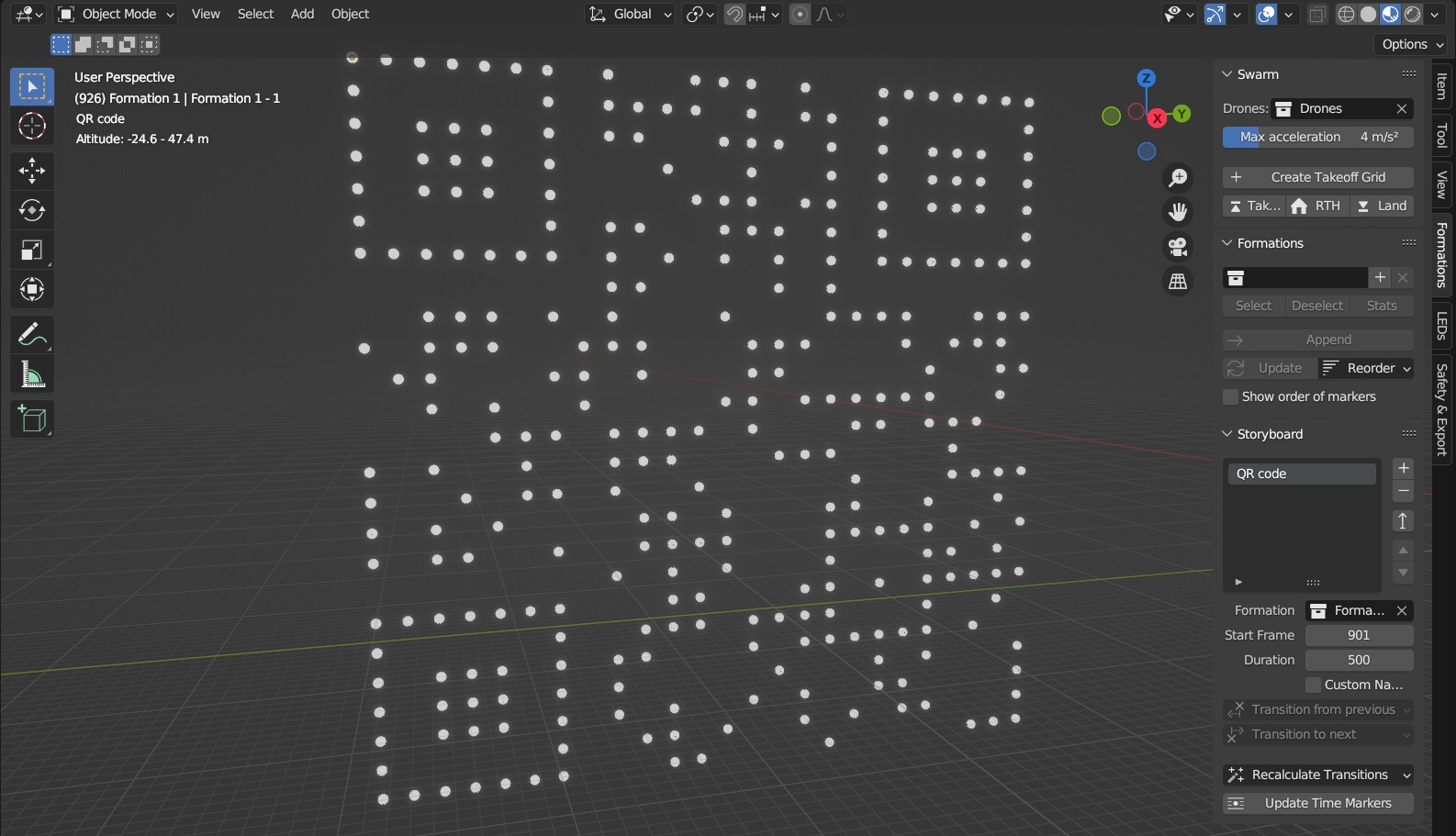We are proud to announce the release of Skybrush Studio for Blender 2.9.0, bringing you the latest advanced drone show design capabilities and many handy enhancements to already existing tools. Below is a list of some of the highlighted features. For more details check out the changelog.
Experimental features #
This release introduces the concept of experimental features in the Blender plugin. Experimental features are hidden by default and you need to opt in explicitly in the add-on preferences dialog to use them. We reserve the right to change, disable or remove experimental features any time in future releases. Experimental features that prove to be successful will be finalized in later releases, at which point we will commit ourselves to keeping them for the foreseeable future.
Multi-phase takeoff support #
Drones before the show can now be arranged in slots. It is ensured by Studio that only one drone per slot will takeoff at a time. The RTH and landing operators are also redesigned to cater for dense takeoff grids. This feature allows for simple multi-phase takeoff design and might also allow operators to use less space for the takeoff, which is usually a relief as takeoff space can be a huge constraint in many cases.
Smart RTH support #
Smart RTH is a new experimental feature. The smart return to home operator brings all the drones to their individual home position with shortest possible flight paths and flight times, while preventing minimal distance conflicts between the drones automatically. With the new smart RTH you do not ever need to worry again about how to end the show, while you also get your drones back to their original takeoff spots which can help in debugging any issues arising during show time.
Modular import of external animation snippets #
A very powerful new feature is the modular import of external animation snippets using the “from CSV” marker generator. State-of-the-art drone shows can become very complex, now you can reduce complexity by modularizing your design, create one formation or animation in one file, export the results in CSV format and import it to the overall show as one storyboard entry with its own corresponding light effect. This way there is much more space to design parametrically and change parts of the animation any time without confusing other parts of the show. This procedure also gives more freedom for creating parts of the animation in any other animation software that might be more suitable for a specific task than Blender.
Color-image based light effects #
A new concept has been introduced to light effect design with color images. While previous light effects used color ramps which are one dimensional, now you can use 2D color images the same way, with both of the dimensions mapped to any of the regular output types. Along with this feature, a new light effect output type called INDEXED_BY_FORMATION is also available, which orders the drones according to the order of markers in the formation of the storyboard entry of a given frame.
With the color image based light effect design you can now draw images in any external program and use that for your light effect in many creative ways. For example, you can assign time to one axis of the image and drones in your formation to another axis and then each line of your color image will become the light effect of a single drone. With color image based light effects custom sparks, nice smooth color rainbows and the manifestation of many other creative ideas are now reduced to simple image design. Use you “imagination” capabilities!
Note that the new feature of importing external animation snippets also relies on color images as the corresponding light effect will be stored simply as an image for the whole fleet.
SVG sampling #
Another experimental feature is the SVG sampling option in the Generate Markers operator. This capability also modularizes drone show design and lets you exploit other artistic concepts and forms of expression for your design, now with bringing in vectorized image drawing. Create your formations with a few colored Bezier lines in any vector image drawing tool (such as Inkscape), export your image as an SVG file and sample it with the required number of drones with only a few clicks in Skybrush Studio.
The SVG sampling operator tries to arrange markers for an SVG drawing in an optimal way where each corner is highlighted and all smooth curves between have approximately the same marker density (subject to drone count constraints). Important notes for this tool:
-
you need to create plain SVG files without any fancy grouping and translation operators. Only path-like objects are supported, images and text are not (we rely on the capabilities of the excellent
svgpathtoolsPython library) -
you might need to experiment with the number of drones: if there are not enough drones, the result will be ugly, but if there are too much, the formation will be too dense. Minimum distance is not checked during an SVG import.
QR code generation #
Due to increased community demand we added a QR code generator to the list of marker generators for a formation. The number of drones in a QR code is fixed and depends on the text and quality of the QR code you need. You will have to extend the formation with additional “dummy” markers to tell the system where the unneeded drones should go while the QR code is shown on the sky.
Providing feedback #
As always, feel free to contact us on Discord for feedback, bug reports, feature requests and ideas. If you would like to report an issue and you know which component of Skybrush is the source of the problem, you can also open an issue in the issue tracker of the corresponding repository on Github.





